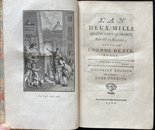The first work of speculative fiction set in the future: "[2440] L'An deux mille quatre cent quarante"
$2,000
“[L’An 2440 ] is a crucial work for anyone who wants to understand what appealed to a readership so different from our own”—Forbidden Bestsellers of Pre-Revolutionary France
[MERCIER (Louis-Sébastien)]. L'An deux mille quatre cent quarante. Rêve s'il en fût jamais ; suivi de l'homme de fer, songe. Nouvelle édition avec figures.
[S.l.], 1786.
3 vols. 8°: v.1: a8 A-2A8 [$4 signed (- a1, a2, 04)]; [i-v] vi-xvi, 1-380, [2] pp. ; v.2: π2 A-2A8 [$4 (-C3, R4; L4 as ‘L2’) signed]; [4], 1-318, [2] pp. (p. 251 as ‘521’, 291 as ‘191’, p. 357 as ‘157). v.3: π2 A-T8 V6 (final leaf blank) [$4 (-B4, V4; S3 as ‘S5’) signed]; [4], 1-312, [2] pp. (p. 73 as ‘74’, p. 191 as ‘190’, p. 260 as ‘360’, p. 269 as ‘369’, p. 304 as ‘306’). Contemporary calfskin, smooth spine ornamented in gilt, triple gilt fillet on the covers, title label in red morocco and vols. in black.
First impression, first issue (octavo format) of the expanded edition with Mercier’s introduction regarding the publishing of the book. Very good copy with large margins; minor traces of dampstain in the margins of the first leaves of the third volume. Following Wilkie, this set reflects his 1786.1a in all points, with the exception of volume 3 having pp. 134-135 correctly paginated and p. 304 as ‘306’.
Definitive and illustrated edition with three frontispieces, partly original. The work was published anonymously for the first time in 1771 in a volume that was immediately banned. Mercier enlarged the novel twice, presenting a two-volume version in 1785, and then in 1786 this definitive three-volume edition. 3 frontispiece engravings, unsigned, which Cohen attributes to Marillier, engraved by de Ghendt.
Louis-Sébastien Mercier (1740-1814), simultaneously novelist, playwright, lexicologist, journalist, essayist and ardent polemicist, was a prolific author whose best-known works include in addition to L’An 2440, Tableau de Paris (1782), Mon Bonnet de nuit (1784), and Néologie (1801).
Unlike his predecessors, Plato, Thomas More, and Francis Bacon who set their works in remote geographical regions, Mercier’s novel is considered to be the first work of speculative fiction set in the future, a moral utopia in which the narrator, who resembles Mercier, falls asleep after a heated philosophical argument about the injustices of contemporary Paris, wakes to find himself in the year 2440, where priests, monasteries, and the papacy, along with, prostitutes, vice, taxes, tobacco, and pastry chefs (!) are all elements of a distant past, and in a new society in which science and secular philosophy rule. The novel is both revelation, one of the very first works of science fiction, and a revolution in its dismissal of the ideals of the Ancient Regime in favor of the principles of the Enlightenment.
Another innovation of Mercier’s work is the use of footnotes to create a double narrative: while the main body of the text relates the utopian future in distinctly descriptive terms, the narrative voice in the footnotes directly addresses the present day reader, moralizing against contemporary 18th century society—in some sections the notes are more copious than the main text, a technique that anticipated David Foster Wallace’s dystopian Infinite Jest by more than 200 years.
Hartig and Soboul, p. 61; Fortunati and Trousson, Dictionary of Literary Utopias, p. 43; Cohen - De Ricci, 701, Wilkie 1786.1.


